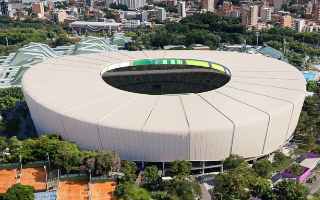Estadio Atanasio Girardot
| Capacity | 60 000 |
|---|---|
| Country | Colombia |
| City | Medellín |
| Clubs | Atlético Nacional, Independiente Medellí |
| Category | Design awaiting implementation |
| Cost | COP 750 B ($198 M) |
| Construction | 2026–2027 |
Advertisement
Estadio Atanasio Girardot – design description
How does the Atanasio Girardot Stadium expansion project look in brief?
The expansion plan for Atanasio Girardot Stadium involves adding a third tier to the stands. This will increase the stadium’s capacity to 60,000 seats, making it the largest stadium in the country.
The arena will also receive a new facade and a full roof covering the stands, while the renovation will include the existing seating areas and facilities. As a result, Medellín will have a modern, high-class football venue.
The project was initiated by the city, and its funding is fully guaranteed from public resources. Construction is expected to begin in May or June 2026, with completion scheduled before the end of 2027.
What is the current state of Atanasio Girardot Stadium?
Atanasio Girardot Stadium is the main sports venue in Medellín, the second-largest city in Colombia. It is part of the larger Unidad Deportiva Atanasio Girardot sports complex. The stadium is named after Atanasio Girardot, one of Colombia’s independence heroes.
The stadium was inaugurated in 1953. Initially, the second tier existed only on the west side. It was extended to the east side in 1977, and the remaining sections of the second tier on the curves were completed in 1990. This gave the stadium its current form, with two-level, oval-shaped stands of varying heights.
With a capacity of around 45,000 seats, the stadium is one of the largest in the country. It formerly featured an athletics track between the pitch and the stands. Today, the facility is no longer considered state-of-the-art, and the roof covers only the main stand.
Atanasio Girardot Stadium is home to Medellín’s two leading football clubs: Atlético Nacional – the country’s most popular and successful team – and Independiente Medellín.
When were plans for the next expansion of Atanasio Girardot Stadium developed?
The first plans for a major expansion of Atanasio Girardot Stadium were drawn up in 2020, during Daniel Quintero’s term as mayor of Medellín. The plan included expanding the stands, adding an eye-catching facade, and covering the stadium with a roof.
The project was intended to be carried out as a public–private partnership. However, the idea of placing the stadium under private management met with strong opposition from residents and from tenants renting space inside the venue.
The new project was initiated by Federico Gutiérrez, who became mayor of Medellín in 2024. The expansion concept was developed by city architects and presented by Gutiérrez himself at the stadium on November 5, 2025.
What does the Atanasio Girardot Stadium expansion plan include?
The plan involves adding a third tier to the stands, increasing capacity to 60,000 seats and making the stadium the largest in the country. The exterior of the stands will receive a new facade and be fully covered by a roof.
As part of the modernization, the existing stands and facilities will also be renovated. The seating areas will be equipped with new seats, the number of restrooms will rise from 399 to 531, and the number of turnstiles will increase from 49 to 108. The old floodlight masts will be removed and replaced with lights integrated into the roof.
VIP boxes, press areas, and locker rooms will also be renovated, and additional food and beverage points will be added. The modernization will also include the replacement of technical installations and improvements to the stadium’s internet infrastructure. Changes will extend to the immediate surroundings of the venue as well.
When will Atanasio Girardot Stadium be expanded?
The expansion of Atanasio Girardot Stadium is scheduled to begin in May or June 2026, with completion planned for the second half of 2027.
During the renovation, there will likely be periods when the stadium needs to be temporarily closed, particularly for the installation of the new roof. Estadio Cincuentenario has been suggested as a potential alternative venue.
The expansion is expected to cost 750 billion pesos and will be secured with public funds, ensuring stability for tenants without relying on private entities. At the same time, authorities remain open to collaboration with private investors.
Advertisement
Renderings
-

2025 © Alcaldía de Medellín 
2025 © Alcaldía de Medellín 
2025 © Alcaldía de Medellín 
2025 © Alcaldía de Medellín 
2025 © Alcaldía de Medellín 
2025 © Alcaldía de Medellín

 StadiumDB
StadiumDB